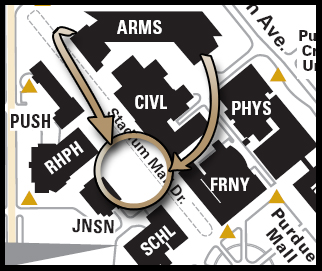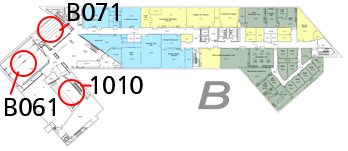ENE Safety
Wang Hall emergency procedures have been added below.
In the School of Engineering Education (ENE), Safety is critically important in everything that we do. From our Research Labs to our classrooms, we must always keep the Safety of students, faculty, and staff the top priority.
There are four key areas of Safety within ENE: Office Safety, Lab Safety, Classroom Safety, and Emergency Response. On the page below, you will find information that addresses all three areas, plus additional general safety information.
For any safety concerns or suggestions for this web page, please contact Nicole Towner at ntowner@purdue.edu, or 494-1503.
Safety Committee
Click here for the ENE Safety Committee meeting minutes.
Right To Know Program and Training
The purpose of the Right To Know Program and Training is to:
- Provide employees with knowledge to understand the hazards of the chemicals with which they work.
- Provide a safer and healthier workplace for all employees.
- Ensure regulatory compliance with State and Federal Hazard Communications Standard, 29 CFR 1910.1200.
ALL ENE employees are required to have attended Right To Know Training. If you have not attended a Right To Know training session, please contact Nicole Towner at ntowner@purdue.edu, or 494-1503.
There are 4 main items you need to know about the ENE Right To Know Program:
- Be aware of the existence of the ENE Right To Know Program and your rights and responsibilities in the program.
- Know the location of the ENE Hazard Communication Compliance Manual (located in ARMS B122 and on-line here).
- Know who the ENE Designated Trained Individuals (DTI) are with regard to the Right-To-Know Program (Jeff Huddleston is the DTI for ENE).
- Know the locations of the chemical inventory and MSDS sheets within ENE (located in the ENE kitchenette area, ARMS B089, ARMS B098, and ARMS B103).
Right-To-Know resources are available here:
- REM Hazard Communication Training (please complete the “Awareness Training” found at the link under 'H') Forward record of completion to Nicole Towner at ntowner@purdue.edu.
- ENE Right To Know Training Module (This modules serves as a reference. If you have not yet completed training, please contact Nicole Towner at ntowner@purdue.edu, or 494-1503.)
- Purdue University Hazard Communication Compliance Manual
Office Safety
Office Safety is actually a complex process that can be easily taken for granted. All ENE office spaces will be audited yearly by the ENE Safety Committee (typically in Oct/Nov). To prepare for the yearly Safety Audit, below is an "Office Self-Audit" checklist and other Office Safety information to help you prepare.
The most common Office Safety violations are:
- Sprinkler heads unobstructed in all directions with no obstructions in a plane 18 inches below the head
- 22 inches wide clearance in office areas
- Daisy chaining of power strips
- Use of thermal resistant ceramic tile underneath any coffee/tea maker
Lab Safety
Lab Safety is primarily the responsibility of the faculty or staff member designated as person-in-charge of the lab. All ENE lab spaces will be audited yearly by the ENE Safety Committee (typically in Oct/Nov). Below are several documents to help you prepare .
-
Material Safety Data Sheet (MSDS) Binder
If any chemicals are stored in a lab, it is required to maintain a binder of up-to-date MSDSs for the chemicals that are in use in the laboratory. MSDSs are typically available on vendor websites. - Chemical Inventory Form (HCP-4)
-
Hazard Assessment Form
The Hazard Assessment should be reviewed and updated annually or when new hazards are introduced to the laboratory. -
Laboratory Door Posting
The Door Posting should be updated annually or when personnel changes occur in the laboratory. - Eye washes should be flushed weekly.
- The area beneath safety showers marked by green and white tape should be kept clear at all times.
- Integrated Safety Plan Self-Audit Checklist
Classroom Safety
Classroom Safety encompasses three key areas: Emergency Procedures, Keeping Aisle-Ways Clear, and Limiting the Spread of Germs.
-
Emergency Procedures:
- All First-Year Engineering courses follow a comprehensive Emergency Response Plan. The plan is available here.
- If you require specific courseware related to emergency response procedures, contact a member of the Instructional Support Team or a member of the Safety Committee.
- Keeping Aisle-Ways Clear: always be on the look-out for trip hazards and blocked aisle-ways that could cause students to trip and fall. Remember that aisle-ways must be at least 22 inches wide in office areas or 36 inches wide in high traffic and high hazard areas such as classrooms.
- Limit the Spread of Germs. Here is information provided by the CDC and PUSH: Recommendations for Limiting the Spread of Germs
Armstrong Hall Emergency Procedures
A comprehensive listing of all Armstrong Hall emergency procedures and other information is available in the Building Emergency Plan (BEP). Click the link below to access the ARMS BEP.
The two most common emergency situations encountered at Purdue are typically related to fire alarms and severe weather sirens. Below are the respective evacuation/shelter-in-place locations for these types of emergencies. A more comprehensive listing of these procedures is available in the ARMS BEP, FYE Emergency Response Plan, or Purdue Emergency Procedure Flipchart.
| FIRE ALARM: | ALL HAZARDS SIRENS (related to severe weather): |
| ARMS Evacuation Location | ARMS Severe Weather Shelter-In-Place Locations |
 |
 |
| located between Civil Engineering and Nursing | proceed to ARMS lower level |
Wang Hall Emergency Procedures
A comprehensive listing of all Armstrong Hall emergency procedures and other information is available in the Building Emergency Plan (BEP). Click the link below to access the ARMS BEP.
The two most common emergency situations encountered at Purdue at fire alarms and severe weather alerts. The evacuation/shelter-in-place locations for these two types of emergencies are below (as described in the BEP):
Fire Alarm: The evacuation location for the ENE spaces in WANG is the grassy area to the north of the rear parking lot (shown in the photo below). Use the nearest stairwell to exit the building. Do not use the elevator.
Severe Weather Shelter-In-Place: The severe weather shelter-in-place location for WANG is any space on the first floor that is away from windows and other glass. Ideally, the first floor stairwell, restrooms, and janitor area are to be used. An alternate shelter-in-place location is the tunnel underneath the Northwestern Parking Garage. This location should only be used if it is safe to briefly travel outdoors.
An ENE emergency response plan for WANG will be developed in the coming months.
Purdue Emergency Preparedness and Planning Office
Below are resources provided by the Purdue Emergency Preparedness and Planning Office, more information is available on the office's website (linked above):
- Classroom Emergency Plans - College of Engineering
- Purdue Emergency Procedures: Quick Reference Guide
- Purdue Emergency Procedures Flipchart
"Lessons Learned" Reporting
The College of Engineering has now implemented a “Lessons Learned” program. A “Lessons Learned” (also known as a “near-miss” in the corporate setting) is an event that may have resulted in personal injury, equipment damage, or reduction in system integrity — but DID NOT occur. If you are involved in or witness a “Lessons Learned” event, you are encouraged to anonymously submit an on-line form to report the event here. The lessons learned form is designed to help Schools and the College of Engineering prevent accidents by alerting safety committee members to potential issues.
Accidents Do Happen at Universities
The following are news articles related to accidents that occurred within university laboratories/classrooms:
- UCLA - May 2009
- Georgia Tech - June 2010
- University of Missouri - June 2010
- Yale University - April 2011
- Chemical Safety Board (CSB) Video on Laboratory Safety
Workplace Injury Information
- Worker's Compensation: Steps to Take if You Are Injured or Become Ill on the Job
- Purdue Students - Where to Seek Medical Treatment
- First Report of Injury Form
- REM Injury Portal
Radiological & Environmental Management Safety Resources
Last Updated: February 8, 2021 Safety Committee and Contact Info
